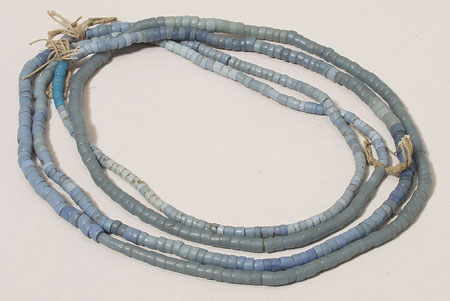Accession Number:
1951.7.1
Country:
Sudan
Region:
[Southern Sudan]
Cultural Group:
Anywaa [Anuak]
Date Made:
By 1951
Materials:
Glass , ?Cotton Yarn Plant , String
Process:
?Drawn , Strung , Twisted , Tied
Dimensions:
L string = 790 mm, Diam cord = 1 mm, Diam beads = 4 to 4.5 mm, Min L beads = 2 mm, Max L beads = 5 mm [RTS 24/5/2004].
Weight:
58.9 g
Local Name:
dimui
Other Owners:
Presumably collected by Evans-Pritchard during his period of fieldwork amongst the Anuak between early March and May 1935 [RTS 18/6/2004].
Field Collector:
Edward Evan Evans-Pritchard?
PRM Source:
Edward Evan Evans-Pritchard
Acquired:
Donated 1951
Collected Date:
March - May 1935
Description:
Long cord made of three shorter lengths of cotton knotted together, each length being made from multiple twisted strands.
This cord has been threaded with 522 blue glass beads, covering a range of shades, from 6 bright blue beads (Pantone 7459C), to numerous light bluish mauve (Pantone 7453C), and very pale bluish grey colour beads (Pantone 7542C).
This is consistent with the way in which the object was made, with beads being added to the necklace over time, and probably differing in age and perhaps origin.
The arrangement of the different shades of blue does not seem to form a deliberate pattern.
Although beads with a similar diameter have been chosen, the length of each bead seems more variable, ranging from medium sized disc beads to short cylindrical beads.
Several of the beads have been chipped.
The length of the necklace, as strung (and doubled up) is 790 mm; the cord has a diameter of 1 mm, while the beads themselves vary in diameter from 4 to 4.5 mm, and in length from 2 to 5 mm, with a weight of 58.9 grams.
Collected by E.E. Evans-Pritchard during his fieldwork amongst the Anuak, which took place between early March and May 1935 (E.E. Evans-Pritchard, 1940, The Political System of the Anuak of the Anglo-Egyptian Sudan, p. 3).
The beads in this necklace are called dimui, and are both rare and valuable. At the time they were collected, they cost approximately one or two piastres each. They are used as a form of bride wealth and as compensation for injuries. This necklace would have been the bride wealth for one wife. “ A string of such beads consists of about a hundred beads which a man may have taken some years to collect. These strings are very rare and the beads have a scarcity value which increases with time since they are sometimes lost and can never be replaced, for Anuak say that their ancestors brought them from their homeland' (E.E. Evans-Pritchard, 1940, The Political System of the Anuak of the Anglo-Egyptian Sudan, p. 55). This ancestral home lies to the south west; Evans-Pritchard found similar beads on the shores of Lake Victoria, which are now in the Cambridge Museum of Archaeology and Anthropology.
This object is currently on display in the Lower Gallery, case 101A.
Rachael Sparks 25/9/2005.
Collected by E.E. Evans-Pritchard during his fieldwork amongst the Anuak, which took place between early March and May 1935 (E.E. Evans-Pritchard, 1940, The Political System of the Anuak of the Anglo-Egyptian Sudan, p. 3).
The beads in this necklace are called dimui, and are both rare and valuable. At the time they were collected, they cost approximately one or two piastres each. They are used as a form of bride wealth and as compensation for injuries. This necklace would have been the bride wealth for one wife. “ A string of such beads consists of about a hundred beads which a man may have taken some years to collect. These strings are very rare and the beads have a scarcity value which increases with time since they are sometimes lost and can never be replaced, for Anuak say that their ancestors brought them from their homeland' (E.E. Evans-Pritchard, 1940, The Political System of the Anuak of the Anglo-Egyptian Sudan, p. 55). This ancestral home lies to the south west; Evans-Pritchard found similar beads on the shores of Lake Victoria, which are now in the Cambridge Museum of Archaeology and Anthropology.
This object is currently on display in the Lower Gallery, case 101A.
Rachael Sparks 25/9/2005.
Primary Documentation:
Accession Book Entry
[pp 49-50] - PROFESSOR E.
E.
EVANS PRITCHARD, INSTITUTE OF SOCIAL ANTHROPOLOGY, UNIVERSITY OF OXFORD.
1951.7.1 - A[nglo].E[gyptian].
SUDAN.
ANUAK TRIBE.
Necklace of blue-grey glass beads, with 6 of brighter blue, c.
31” long (double).
These beads [insert] (
dimui
) [end insert] are rare and valuable (costing about 2/- each at the present time).
Anuak say they brought them from their ancestral home in the south-west.
Some like them were found by donor on the shore of Lake Victoria (now in the Cambridge Museum).
The necklaces are built up by ones and twos and are heirlooms.
This one would be the bride-wealth for one wife.
See Evans-Pritchard ‘The Political System of the Anuak’, 1940, p.
55.
Card Catalogue Entry - There is no further information on the catalogue card [RTS 30/1/2004].
Old Pitt Rivers Museum label - ANGLO-EGYPTIAN SUDAN, ANUAK TRIBE. Rare and valuable necklace of ancient beads ( dimui ), used as bride-wealth etc. Value = 1 wife. d.d. Prof. E.E. Evans-Pritchard 1951.7.1 [rectangular metal-edged tag, tied to object, RTS 24/5/2004].
Card Catalogue Entry - There is no further information on the catalogue card [RTS 30/1/2004].
Old Pitt Rivers Museum label - ANGLO-EGYPTIAN SUDAN, ANUAK TRIBE. Rare and valuable necklace of ancient beads ( dimui ), used as bride-wealth etc. Value = 1 wife. d.d. Prof. E.E. Evans-Pritchard 1951.7.1 [rectangular metal-edged tag, tied to object, RTS 24/5/2004].



